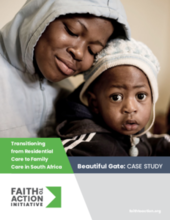Beautiful Gate was established in 1994 by a Dutch missionary couple who simply desired to do what was “just, good, and right” for children. It began as a children’s home for children living on the streets in the suburb of Muizenberg in Cape Town, South Africa. In 1999, at the request of the government, a second location was opened in the neighboring township of Crossroads as a hospice for children dying of HIV/AIDS. The hospice eventually moved to a new site in the Lower Crossroads area in 2004. The larger site made possible additional community services, including a medical clinic, community-based services for children and families, and an international training center for students studying missions.
Over time, the staff and founders at Beautiful Gate had experiences that made them question their model of care due in large part to the expressed desire of children to be with their birth families. In 2006, a strategic planning process led Beautiful Gate’s leadership to an increased consideration of the value of family and a decision to commit to proactive family strengthening rather than caring for children in residential settings, such as children’s homes or orphanages. Soon after, preparations began for the children in the Muizenberg children’s home to be either reunified with their families or placed in alternative family-based care; a process that was completed in 2008 with the closure of that facility.
This case study documents the successful transition of Beautiful Gate, a children's home in Cape Town, South Africa, from the orphanage model to a family-based and community-based approach. The appointment of a new director in 2007, following its strategic planning process, was instrumental in guiding the transition process. The transition was also fully supported by the founders and the board as well an organizational culture that was committed to doing what was “just, right, and good.”
Yet even with support from the director, board, and founders, the transition was neither quick nor without obstacles. The road from international missions training center to a nationally run organization which entailed fundraising for a new vision; the navigation of siloed government funding; and the complexity of reuniting families, - was rife with hurdles ultimately overcome by skilled staff, carefully selected for their passion and experience.
Related:
- Transitioning from Residential Care to Family Care in South Africa - Beautiful Gate Case Study: Communicating Change with Donors
- Heartline Case Study: Transitioning from Residential Care to Family Care in Haiti
- Buckner Case Study: Transitioning from Residential Care to Family Care in Guatemala
Visit Transition Hub:
Visit the resource hub on transforming systems of care, including the transitioning of institutional care services.

